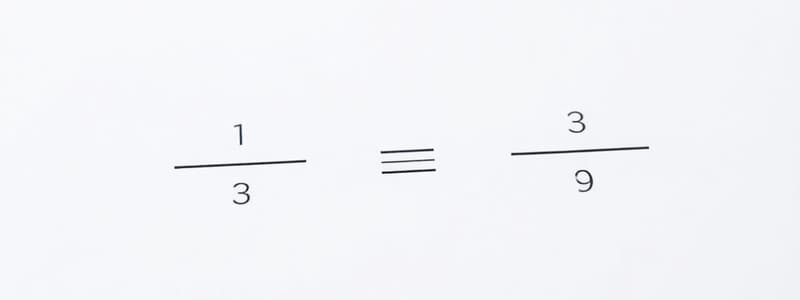Podcast
Questions and Answers
What does the denominator of a fraction represent?
What does the denominator of a fraction represent?
- The color of the parts.
- The number of parts being considered.
- The total number of equal parts in the whole. (correct)
- The greatest common divisor.
The fraction 7/8 represents a quantity larger than 1.
The fraction 7/8 represents a quantity larger than 1.
False (B)
Simplify the fraction 24/36 to its simplest form.
Simplify the fraction 24/36 to its simplest form.
2/3
Which of the following fractions is equivalent to 5/8?
Which of the following fractions is equivalent to 5/8?
To add or subtract fractions, they must have a _______.
To add or subtract fractions, they must have a _______.
What is the least common denominator (LCD) of the fractions 1/4, 2/6, and 5/8?
What is the least common denominator (LCD) of the fractions 1/4, 2/6, and 5/8?
Match each fraction with its simplified form:
Match each fraction with its simplified form:
Arrange the following fractions in ascending order: 2/3, 5/6, 1/2.
Arrange the following fractions in ascending order: 2/3, 5/6, 1/2.
The fraction $\frac{355}{113}$ is a closer approximation to π (pi) than $\frac{22}{7}$.
The fraction $\frac{355}{113}$ is a closer approximation to π (pi) than $\frac{22}{7}$.
If the greatest common divisor (GCD) of the numerator and denominator of a fraction is 1, the fraction is said to be in its _______ form.
If the greatest common divisor (GCD) of the numerator and denominator of a fraction is 1, the fraction is said to be in its _______ form.
Flashcards
What is a fraction?
What is a fraction?
Represents a part of a whole; numerator shows parts considered, denominator shows total equal parts.
What is simplifying fractions?
What is simplifying fractions?
Reducing a fraction to its simplest form by dividing both numerator and denominator by their GCD.
What is a common denominator?
What is a common denominator?
A shared multiple of the denominators in a set of fractions.
What are equivalent fractions?
What are equivalent fractions?
Signup and view all the flashcards
What does LCM stand for?
What does LCM stand for?
Signup and view all the flashcards
How do you order fractions?
How do you order fractions?
Signup and view all the flashcards
Study Notes
- The lecture reviews basic concepts of fractions and provides practice exercises.
Fraction Basics and Identification
- A fraction represents a part of a whole, with the denominator indicating the total number of equal parts and the numerator indicating the number of parts being considered.
- In a visual representation, the denominator is the total number of equal sections in a shape, and the numerator is the number of colored sections.
- For example, if a shape is divided into 5 equal parts and 2 are colored, the fraction representing the colored portion is 2/5.
Exercise 1: Identifying Fractions in Visuals
- In an image divided into 5 parts with only 1 part colored, the fraction represented is 1/5.
- For a star divided into 5 sections with 3 colored, the fraction is 3/5.
- If an image has 10 sections with 4 colored, the fraction is 4/10, which simplifies to 2/5 when reduced.
Exercise 2: Completing a Number Line with Fractions
- Fractions on a number line follow a sequential order based on their values.
- Given a number line with fractions like 1/10, 2/10, and gaps to fill before reaching 5/10, 7/10, and 9/10, students should fill in the missing fractions sequentially.
- The filled number line should read: 1/10, 2/10, 3/10, 4/10, 5/10, 6/10, 7/10, 8/10, 9/10, culminating in 1 (or 10/10).
Exercise 3: Simplifying Fractions
- Simplifying fractions involves reducing them to their simplest form.
- This is achieved by dividing both the numerator and the denominator by their greatest common divisor (GCD).
- Example: 12/18 can be simplified by dividing both parts by 6, resulting in 2/3, which cannot be reduced further.
- 4/40 can be simplified by dividing both by 4, yielding 1/10.
- 18/24 simplifies to 3/4 when divided by 6.
- 20/35 simplifies to 4/7 when divided by 5.
- 60/12 simplifies to 5/1 (or 5) when divided by 12.
Exercise 4: Finding a Common Denominator and Equivalent Fractions
- To compare or perform operations on fractions, they must have the same denominator.
- This is achieved by multiplying the numerator and denominator of each fraction by a factor that results in a common denominator.
- For fractions 2/5 and 3/7, the common denominator can be 35.
- Convert 2/5 to 14/35 (multiply by 7) and 3/7 to 15/35 (multiply by 5).
- When one denominator is a multiple of the other, only one fraction needs to be converted (e.g., 4/15 and 6/45).
- Convert 4/15 to 12/45 (multiply by 3) and keep 6/45 as is.
- With multiple fractions like 1/2, 1/5, and 1/3, finding the least common multiple (LCM) is efficient, such as 30.
- Convert 1/2 to 15/30, 1/5 to 6/30, and 1/3 to 10/30.
Exercise 5: Ordering Fractions
- To arrange fractions in ascending order, they must have a common denominator, and then be ordered by comparing their numerators.
- For fractions 1/3, 1/6, 5/2, and 3/2, first convert them to have the same denominator, such as 6.
- The conversions yield 2/6, 1/6, 15/6, and 9/6.
- This arrangement becomes 1/6 (smallest), 2/6 (or 1/3), 9/6 (or 3/2), and 15/6 (or 5/2, largest).
Studying That Suits You
Use AI to generate personalized quizzes and flashcards to suit your learning preferences.




